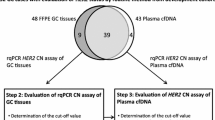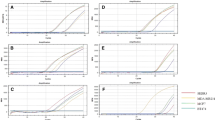Summary
Several studies have demonstrated that tumor cell-derived RNA is presented in the plasma from breast cancer patients. However, no studies have focused on the detection of plasma erbB2 mRNA in breast cancer. In this study the expression of erbB2 mRNA in the plasma was analyzed in 106 breast cancer patients and 50 healthy subjects by using a nested RT-PCR strategy, and the circulating tumor cells were also detected by using a nested RT-PCR for detection of mammaglobin transcripts in the peripheral blood. Plasma erbB2 mRNA was detectable in 46 (43.3%) breast cancer patients, whereas only 5 normal subjects (10%) were positive in the control group (p = 0.001). The presence of erbB2 mRNA in the plasma was not associated with menopausal status, erbB2 expression in primary tumor tissues, tumor size, histological grade, Ki-67 expression or lymph node involvement, but it exhibited a trend for correlation with increasing tumor stages (p = 0.085), and the presence of erbB2 mRNA in the plasma was significantly associated with negative estrogen receptor (ER) and progesterone receptor (PR) status of the primary tumors (p = 0.031 and 0.026, respectively). Furthermore, in a small subset of 36 breast cancer patients we found the presence of plasma erbB2 mRNA was significantly correlated with the occurrence of circulating tumor cells (p = 0.01). Our study suggests that breast cancer patients with the presence of erbB2 mRNA in the plasma may have a high malignancy or an aggressive phenotype, and frequently detecting plasma erbB2 mRNA may provide a novel approach for monitoring breast cancer progression or response to treatment.
Similar content being viewed by others
References
Gao YT, Shu XO, Dai Q, Potter JD, Brinton LA, Wen W, Sellers TA, Kushi LH, Ruan Z, Bostick RM, Jin F, Zheng W: 2000 Association of menstrual and reproductive factors with breast cancer risk: results from the Shanghai Breast Cancer StudyInt J Cancer 87(2): 295–300
Polychemotherapy for early breast cancer: an overview of the randomised trials. Early Breast Cancer Trialists’ Collaborative Group. Lancet 352(9132): 930–942, 1998
Rennstam K, Ahlstedt-Soini M, Baldetorp B, Bendahl PO, Borg A, Karhu R, Tanner M, Tirkkonen M, Isola J: 2003 Patterns of chromosomal imbalances defines subgroups of breast cancer with distinct clinical features and prognosis. A study of 305 tumors by comparative genomic hybridizationCancer Res 63(24): 8861–8868
Keyomarsi K, Tucker SL, Buchholz TA, Callister M, Ding Y, Hortobagyi GN, Bedrosian I, Knickerbocker C, Toyofuku W, Lowe M, Herliczek TW, Bacus SS,: 2002 Cyclin E and survival in patients with breast cancerN Engl J Med 347(20): 1566–1575
Johnson PJ, Lo YM,: 2002 Plasma nucleic acids in the diagnosis and management of malignant diseaseClin Chem 48(8): 1186–1193
Beau-Faller M, Gaub MP, Schneider A, Ducrocq X, Massard G, Gasser B, Chenard MP, Kessler R, Anker P, Stroun M, Weitzenblum E, Pauli G, Wihlm JM, Quoix E, Oudet P,: 2003 Plasma DNA microsatellite panel as sensitive and tumor-specific marker in lung cancer patientsInt J Cancer 105(3): 361–370
Silva JM, Silva J, Sanchez A, Garcia JM, Dominguez G, Provencio M, Sanfrutos L, Jareno E, Colas A, Espana P, Bonilla F,: 2002 Tumor DNA in plasma at diagnosis of breast cancer patients is a valuable predictor of disease-free survivalClin Cancer Res 8(12): 3761–3766
Lo YM, Chiu RW: 2004 The Biology and Diagnostic Applications of Plasma RNAAnn N Y Acad Sci 1022: 135–139
Chan AK, Chiu RW, Lo YM,: 2003 Cell-free nucleic acids in plasma, serum and urine: a new tool in molecular diagnosisAnn Clin Biochem 40(Pt 2): 122–130
Chen XQ, Bonnefoi H, Pelte MF, Lyautey J, Lederrey C, Movarekhi S, Schaeffer P, Mulcahy HE, Meyer P, Stroun M, Anker P: 2000 Telomerase RNA as a detection marker in the serum of breast cancer patientsClin Cancer Res 6(10): 3823–3826
Dasi F, Lledo S, Garcia-Granero E, Ripoll R, Marugan M, Tormo M, Garcia-Conde J, Alino SF,: 2001 Real-time quantification in plasma of human telomerase reverse transcriptase (hTERT) mRNA: a simple blood test to monitor disease in cancer patientsLab Invest 81(5): 767–769
Yarden Y, Sliwkowski MX: 2001 Untangling the ErbB signalling networkNat Rev Mol Cell Biol 2(2): 127–137
Revillion F, Bonneterre J, Peyrat JP: 1998 ERBB2 oncogene in human breast cancer and its clinical significanceEur J Cancer 34(6): 791–808
Tsutsui S, Ohno S, Murakami S, Hachitanda Y, Oda S: 2002 Prognostic value of c-erbB2 expression in breast cancerJ Surg Oncol 79(4): 216–223
Hartmann LC, Ingle JN, Wold LE, Farr GH, Jr, Grill JP, Su JQ, Maihle NJ, Krook JE, Witzig TE, Roche PC: 1994 Prognostic value of c-erbB2 overexpression in axillary lymph node positive breast cancer. Results from a randomized adjuvant treatment protocolCancer 74(11): 2956–2963
Joensuu H, Isola J, Lundin M, Salminen T, Holli K, Kataja V, Pylkkanen L, Turpeenniemi-Hujanen T, von Smitten K, Lundin J: 2003 Amplification of erbB2 and erbB2 expression are superior to estrogen receptor status as risk factors for distant recurrence in pT1N0M0 breast cancer: a nationwide population-based studyClin Cancer Res 9(3): 923–930
Zehentner BK, Carter D: 2004 Mammaglobin: a candidate diagnostic marker for breast cancerClin Biochem 37(4): 249–257
Zach O, Kasparu H, Wagner H, Krieger O, Lutz D: 2000 Mammaglobin as a marker for the detection of tumor cells in the peripheral blood of breast cancer patientsAnn N Y Acad Sci 923: 343–345
Grunewald K, Haun M, Urbanek M, Fiegl M, Muller-Holzner E, Gunsilius E, Dunser M, Marth C, Gastl G: 2000 Mammaglobin gene expression: a superior marker of breast cancer cells in peripheral blood in comparison to epidermal-growth-factor receptor and cytokeratin-19Lab Invest 80(7): 1071–1077
Nilsson G, Skytting B, Xie Y, Brodin B, Perfekt R, Mandahl N, Lundeberg J, Uhlen M, Larsson O: 1999 The SYT-SSX1 variant of synovial sarcoma is associated with a high rate of tumor cell proliferation and poor clinical outcomeCancer Res 59(13): 3180–3184
Ng EK, Tsui NB, Lam NY, Chiu RW, Yu SC, Wong SC, Lo ES, Rainer TH, Johnson PJ, Lo YM: 2002 Presence of filterable and nonfilterable mRNA in the plasma of cancer patients and healthy individualsClin Chem 48(8): 1212–1217
Fleischhacker M, Beinert T, Ermitsch M, Seferi D, Possinger K, Engelmann C, Jandrig B: 2001 Detection of amplifiable messenger RNA in the serum of patients with lung cancerAnn N Y Acad Sci 945 179–188
Howell A, Barnes DM, Harland RN, Redford J, Bramwell VH, Wilkinson MJ, Swindell R, Crowther D, Sellwood RA: 1984 Steroid-hormone receptors and survival after first relapse in breast cancerLancet 1(8377): 588–591
Silva JM, Dominguez G, Silva J, Garcia JM, Sanchez A, Rodriguez O, Provencio M, Espana P, Bonilla F,: 2001 Detection of epithelial messenger RNA in the plasma of breast cancer patients is associated with poor prognosis tumor characteristicsClin Cancer Res 7(9): 2821–2825
Braun S, Schlimok G, Heumos I, Schaller G, Riethdorf L, Riethmuller G, Pantel K: 2001 ErbB2 overexpression on occult metastatic cells in bone marrow predicts poor clinical outcome of stage I–III breast cancer patientsCancer Res 61(5): 1890–1895
Meng S, Tripathy D, Shete S, Ashfaq R, Haley B, Perkins S, Beitsch P, Khan A, Euhus D, Osborne C, Frenkel E, Hoover S, Leitch M, Clifford E, Vitetta E, Morrison L, Herlyn D, Terstappen LW, Fleming T, Fehm T, Tucker T, Lane N, Wang J, Uhr J: 2004 HER-2 gene amplification can be acquired as breast cancer progressesProc Natl Acad Sci U S A 101(25): 9393–9398
Meng S, Tripathy D, Frenkel EP, Shete S, Naftalis EZ, Huth JF, Beitsch PD, Leitch M, Hoover S, Euhus D, Haley B, Morrison L, Fleming TP, Herlyn D, Terstappen LW, Fehm T, Tucker TF, Lane N, Wang J, Uhr JW: 2004 Circulating tumor cells in patients with breast cancer dormancyClin Cancer Res 10(24): 8152–8162
Stathopoulou A, Vlachonikolis I, Mavroudis D, Perraki M, Kouroussis C, Apostolaki S, Malamos N, Kakolyris S, Kotsakis A, Xenidis N, Reppa D, Georgoulias V: 2002 Molecular detection of cytokeratin-19-positive cells in the peripheral blood of patients with operable breast cancer: evaluation of their prognostic significanceJ Clin Oncol 20(16): 3404–3412
Xenidis N, Vlachonikolis I, Mavroudis D, Perraki M, Stathopoulou A, Malamos N, Kouroussis C, Kakolyris S, Apostolaki S, Vardakis N, Lianidou E, Georgoulias V: 2003 Peripheral blood circulating cytokeratin-19 mRNA-positive cells after the completion of adjuvant chemotherapy in patients with operable breast cancerAnn Oncol 14(6): 849–855
Acknowledgments
This study was supported by a grant (03-06) from the Beijing Cancer Hospital, Peking University School of Oncology.
Author information
Authors and Affiliations
Corresponding author
Rights and permissions
About this article
Cite this article
Xu, Y., Yao, L., Li, H. et al. Presence of erbB2 mRNA in the plasma of breast cancer patients is associated with circulating tumor cells and negative estrogen and progesterone receptor status. Breast Cancer Res Treat 97, 49–55 (2006). https://doi.org/10.1007/s10549-005-9086-7
Published:
Issue Date:
DOI: https://doi.org/10.1007/s10549-005-9086-7




